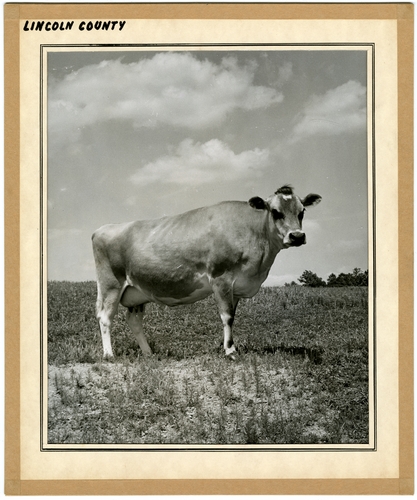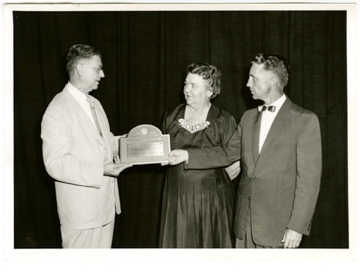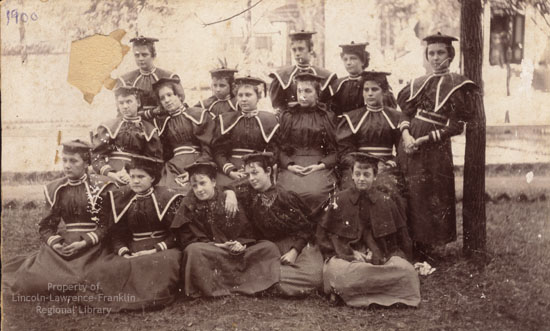Once, it was the largest department store between New Orleans and Memphis.
Employing 40 to 50 people, John McGrath & Sons had something for everyone -- a full grocery store, furnishings, a shoe department, a men's department, and a women's department 20 people strong that offered piece goods and notions, including the services of a milliner from St. Louis and a modiste.
Employing 40 to 50 people, John McGrath & Sons had something for everyone -- a full grocery store, furnishings, a shoe department, a men's department, and a women's department 20 people strong that offered piece goods and notions, including the services of a milliner from St. Louis and a modiste.
Opened in 1878 and located in the Daly* Building, which sported pressed brick and plate glass windows on the ground floor, the store was flooded with natural light during the day and, eventually, the building had some of the earliest electric lighting to illuminate the merchandise once the sun slipped below the horizon.
At the turn of the century, the store, which was a quick jaunt from the train depot, was more advanced than anything the state capital of Jackson (some 60 miles due north) had to offer, according to Jasper Benoit "Jap" Becker, a McGrath grandson who started working in the store when he was a mere lad of 14.
With aisle chairs and a basket trolley system for taking money, making change and giving receipts, the store offered up "the latest" in almost everything.
Fashion shows were all-day affairs, with people from miles around arriving to see the latest in everything, eat free food samples, and listen to live music. Trade days and bargain days drew large crowds as well, not to mention the weekly contests that offered cash prizes.
The McGraths -- Martin McGrath in particular -- understood merchandizing better than most. "Thirty-six inches to the yard and your child can trade here as cheaply as you can" -- was the store motto.
And they wisely didn't just cater to the well-to-do. Offering store credit, they sold fertilizer and goods that farmers would need to keep their rural operations running.
To draw people into town and into the store, McGrath's had countless "openings." An orchestra would play all day, their music magnified over loudspeakers and piped into all departments -- another first for the region.
In the grocery department, the National Biscuit Company, meat and coffee companies would send their salesman to offer up free samples of different products.
Later, fully understanding that women love the latest in fashion, the store merchandisers started sponsoring style shows, which progressed to night-time extravaganzas on the gallery roof above the sidewalk. Singing and tap dancing by locals Roxie and Elsie Moodie and solos by Junius Johnson were also part of the draw.
At times, name entertainment would be employed to draw folks into the store. And other times, country fiddlers would be invited to play for the crowds, sometimes with only one string left on their violins. That, according to Jap Becker, drove crazy many of the employees, who were unable to escape the sounds of their hours-long screeching.
Perhaps more enticing to the rurals were the contests sponsored by McGrath's. There were "wagon load" challenges to see how many people could crowd into a wagon and come into town on Saturdays drew folks from miles around.
The store also handed "clock cards" -- for every dollar spent, a customer got a card with a time on it advertising merchandise. Knowing there was money to be made with Lady Luck, people would collect suitcases full.
It worked like this: a wind-up clock was placed in the store window, the face covered. An employee would half-wind it and soon the clock would stop. Every Saturday, the merchants would uncover the clock face and give away $50 to the person who held a time card closest to the time that the clock had stopped -- a princely sum back in the day.
-----
Born in 1899, 10th-grader Jap Becker went to work in the family store in 1913 when his his father's bank closed during a panic. He was "curious and tried to learn" and, apparently, that gumption and ambition paid off. When he turned 15, he was sent to Chicago to take a two-month course in merchandising and window trimming.
The following year, at just 16, he would travel to New York City, alone, on the train.
He got a map of the city before he left, arrived in one piece and walked three blocks to his hotel room, saving fifty cents worth of cab fare in the process. These buying trips to New York became de rigueur, and while in New York, he would attend Broadway shows and bring back sheet music, which his Aunt Katie would adapt for the store's many openings.
He got a map of the city before he left, arrived in one piece and walked three blocks to his hotel room, saving fifty cents worth of cab fare in the process. These buying trips to New York became de rigueur, and while in New York, he would attend Broadway shows and bring back sheet music, which his Aunt Katie would adapt for the store's many openings.
As luck and fate would have it, Jap Becker entered the world of fashion at the dawn of ladies' ready-to-wear.
Recognizing an opportunity, he parlayed that new interest into added value for the store.
Whitworth College, a Methodist Church-sponsored institution of higher learner for women, was located in the heart of town.
"They wore those long black robes when they went out walking and had to walk two-by-two with a chaperone in front and with a chaperone in the back with a whip, I think, from the school," he said in an interview on file at the Lincoln, Lawrence, Franklin Library.
"And then they finally decided they'd have a uniform instead of robes when they went out. So they bought them from McGraths ... I went to New York, I got some samples ... they liked one, and that was the biggest sale in the ready-to-wear department.
"I bought other things, everything I bought sold, so I was kind of confident from that," he told his interviewer, Henry Ware Hobbs, Esq.
----
There is much more to this story, so please stay tuned ...
Recognizing an opportunity, he parlayed that new interest into added value for the store.
Whitworth College, a Methodist Church-sponsored institution of higher learner for women, was located in the heart of town.
"They wore those long black robes when they went out walking and had to walk two-by-two with a chaperone in front and with a chaperone in the back with a whip, I think, from the school," he said in an interview on file at the Lincoln, Lawrence, Franklin Library.
"And then they finally decided they'd have a uniform instead of robes when they went out. So they bought them from McGraths ... I went to New York, I got some samples ... they liked one, and that was the biggest sale in the ready-to-wear department.
"I bought other things, everything I bought sold, so I was kind of confident from that," he told his interviewer, Henry Ware Hobbs, Esq.
----
There is much more to this story, so please stay tuned ...
-----
Information for this article was gleaned from numerous sources, including Becker/McGrath descendent Bettie Hatcher Cox, to whom I am ever so grateful for helping me tease out the "facts;" the Lincoln, Lawrence, Franklin Library online interviews, Durr Walker's Lincoln County history book, and Findagrave.
-----
*Some sources have the spelling as Daily, others as Daly. If anyone knows the definitive answer as to the correct spelling, please leave me a message here or on my Facebook page.
Information for this article was gleaned from numerous sources, including Becker/McGrath descendent Bettie Hatcher Cox, to whom I am ever so grateful for helping me tease out the "facts;" the Lincoln, Lawrence, Franklin Library online interviews, Durr Walker's Lincoln County history book, and Findagrave.
-----
*Some sources have the spelling as Daily, others as Daly. If anyone knows the definitive answer as to the correct spelling, please leave me a message here or on my Facebook page.






































